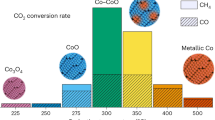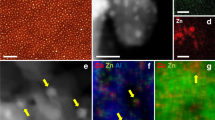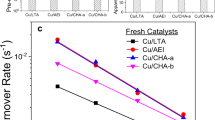Abstract
Metal–support interactions have a strong impact on the performance of heterogeneous catalysts. Specific sites at the metal–support interface can give rise to unusual high reactivity, and there is a growing interest in optimizing not only the properties of metal particles but also the metal–support interface. Here, we demonstrate how varying the particle size of the support (ceria–zirconia) can be used to tune the metal–support interactions, resulting in a substantially enhanced CO2 hydrogenation rate. A combination of X-ray diffraction, X-ray absorption spectroscopy, near-ambient pressure X-ray photoelectron spectroscopy, transmission electron microscopy and infrared spectroscopy provides insight into the active sites at the interface between cobalt and ceria–zirconia involved in CO2 hydrogenation to CH4. Reverse oxygen spillover from the support during treatment in hydrogen results in the generation of oxygen vacancies. Stabilization of cobalt particles by ceria–zirconia particles of intermediate size leads to oxygen spillover to the support during the CO2 and CO dissociation steps, followed by further hydrogenation of the resulting intermediates on cobalt.

This is a preview of subscription content, access via your institution
Access options
Access Nature and 54 other Nature Portfolio journals
Get Nature+, our best-value online-access subscription
$29.99 / 30 days
cancel any time
Subscribe to this journal
Receive 12 digital issues and online access to articles
$119.00 per year
only $9.92 per issue
Buy this article
- Purchase on Springer Link
- Instant access to full article PDF
Prices may be subject to local taxes which are calculated during checkout




Similar content being viewed by others
Data availability
The data that support the findings of this study are available from the authors upon reasonable request.
References
Matsubu, J. C., Yang, V. N. & Christopher, P. Isolated metal active site concentration and stability control catalytic CO2 reduction selectivity. J. Am. Chem. Soc. 137, 3076–3084 (2015).
van Deelen, T. W., Hernández Mejía, C. & de Jong, K. P. Control of metal–support interactions in heterogeneous catalysts to enhance activity and selectivity. Nat. Catal. 2, 955–970 (2019).
Tauster, S. J., Fung, S. C. & Garten, R. L. Strong metal–support interactions. Group 8 noble metals supported on TiO2. J. Am. Chem. Soc. 100, 170–175 (1978).
Tauster, S. J., Fung, S. C., Baker, R. T. K. & Horsley, J. A. Strong interactions in supported-metal catalysts. Science 211, 1121–1125 (1981).
Tauster, S. J. Strong metal–support interactions. Acc. Chem. Res. 20, 389–394 (1987).
Li, M. & van Veen, A. C. Tuning the catalytic performance of Ni-catalysed dry reforming of methane and carbon deposition via Ni-CeO2-x interaction. Appl. Catal. B Environ. 237, 641–648 (2018).
Melaet, G. et al. Evidence of highly active cobalt oxide catalyst for the Fischer–Tropsch synthesis and CO2 hydrogenation. J. Am. Chem. Soc. 136, 2260–2263 (2014).
Macino, M. et al. Tuning of catalytic sites in Pt/TiO2 catalysts for the chemoselective hydrogenation of 3-nitrostyrene. Nat. Catal. 2, 873–881 (2019).
Liu, X. et al. Strong metal–support interactions between gold nanoparticles and ZnO nanorods in CO oxidation. J. Am. Chem. Soc. 134, 10251–10258 (2012).
Tang, H. et al. Strong metal–support interactions between gold nanoparticles and nonoxides. J. Am. Chem. Soc. 138, 56–59 (2016).
Matsubu, J. C. et al. Adsorbate-mediated strong metal–support interactions in oxide-supported Rh catalysts. Nat. Chem. 9, 120–127 (2017).
Tang, H. et al. Classical strong metal–support interactions between gold nanoparticles and titanium dioxide. Sci. Adv. 3, e1700231 (2017).
Daelman, N., Capdevila-Cortada, M. & López, N. Dynamic charge and oxidation state of Pt/CeO2 single-atom catalysts. Nat. Mater. 18, 1215–1221 (2019).
Liu, J. J. Advanced electron microscopy of metal–support interactions in supported metal catalysts. ChemCatChem 3, 934–948 (2011).
Willinger, M. G. et al. A case of strong metal–support interactions: combining advanced microscopy and model systems to elucidate the atomic structure of interfaces. Angew. Chem. Int. Ed. 53, 5998–6001 (2014).
Madhusudhan Rao, P., Viswanathan, B. & Viswanath, R. P. Strong metal support interaction state in the Fe/TiO2 system—an XPS study. J. Mater. Sci. 30, 4980–4985 (1995).
Hernández Mejía, C., van Deelen, T. W. & de Jong, K. P. Activity enhancement of cobalt catalysts by tuning metal–support interactions. Nat. Commun. 9, 4459 (2018).
Li, J. et al. Enhanced CO2 methanation activity of Ni/anatase catalyst by tuning strong metal–support interactions. ACS Catal. 9, 6342–6348 (2019).
Zhang, J. et al. Wet-chemistry strong metal–support interactions in titania-supported Au catalysts. J. Am. Chem. Soc. 141, 2975–2983 (2019).
Trovarelli, A., de Leitenburg, C. & Dolcetti, G. CO and CO2 hydrogenation under transient conditions over Rh–CeO2: novel positive effects of metal–support interaction on catalytic activity and selectivity. J. Chem. Soc. Chem. Commun. 472–473 (1991).
Bernal, S. et al. Some recent results on metal/support interaction effects in NM/CeO2 (NM: noble metal) catalysts. Catal. Today 50, 175–206 (1999).
Lykhach, Y. et al. Counting electrons on supported nanoparticles. Nat. Mater. 15, 284–288 (2016).
Pereira-Hernández, X. I. et al. Tuning Pt–CeO2 interactions by high-temperature vapor-phase synthesis for improved reducibility of lattice oxygen. Nat. Commun. 10, 1358 (2019).
Farmer, J. A. & Campbell, C. T. Ceria maintains smaller metal catalyst particles by strong metal–support bonding. Science 329, 933–936 (2010).
Graciani, J. et al. Highly active copper–ceria and copper–ceria–titania catalysts for methanol synthesis from CO2. Science 345, 546–550 (2014).
Senanayake, S. D. et al. Hydrogenation of CO2 to methanol on CeOx/Cu(111) and ZnO/Cu(111) catalysts: role of the metal–oxide interface and importance of Ce3+ sites. J. Phys. Chem. C 120, 1778–1784 (2016).
Aldana, P. A. U. et al. Catalytic CO2 valorization into CH4 on Ni-based ceria–zirconia. Reaction mechanism by operando IR spectroscopy. Catal. Today 215, 201–207 (2013).
Wang, W., Wang, S., Ma, X. & Gong, J. Recent advances in catalytic hydrogenation of carbon dioxide. Chem. Soc. Rev. 40, 3703–3727 (2011).
Vogt, C., Monai, M., Kramer, G. J. & Weckhuysen, B. M. The renaissance of the Sabatier reaction and its applications on Earth and in space. Nat. Catal. 2, 188–197 (2019).
Vogt, C. et al. Unravelling structure sensitivity in CO2 hydrogenation over nickel. Nat. Catal. 1, 127–134 (2018).
Boaro, M., Colussi, S. & Trovarelli, A. Ceria-based materials in hydrogenation and reforming reactions for CO2 valorization. Front. Chem. 7, 28 (2019).
Díez-Ramírez, J. et al. Effect of support nature on the cobalt-catalyzed CO2 hydrogenation. J. CO 2 Util. 21, 562–571 (2017).
Zhang, F. et al. In situ elucidation of the active state of Co–CeOx catalysts in the dry reforming of methane: the important role of the reducible oxide support and interactions with cobalt. ACS Catal. 8, 3550–3560 (2018).
Wang, L., Liu, H., Chen, Y. & Yang, S. Reverse water–gas shift reaction over co-precipitated Co–CeO2 catalysts: effect of Co content on selectivity and carbon formation. Int. J. Hydrog. Energy 42, 3682–3689 (2017).
Jha, A., Jeong, D.-W., Lee, Y.-L., Nah, I. W. & Roh, H.-S. Enhancing the catalytic performance of cobalt oxide by doping on ceria in the high temperature water–gas shift reaction. RSC Adv. 5, 103023–103029 (2015).
Jiao, L. & Regalbuto, J. R. The synthesis of highly dispersed noble and base metals on silica via strong electrostatic adsorption: I. Amorphous silica. J. Catal. 260, 329–341 (2008).
Parastaev, A., Hoeben, W. F. L. M., van Heesch, B. E. J. M., Kosinov, N. & Hensen, E. J. M. Temperature-programmed plasma surface reaction: an approach to determine plasma-catalytic performance. Appl. Catal. B Environ. 239, 168–177 (2018).
Munnik, P., de Jongh, P. E. & de Jong, K. P. Recent developments in the synthesis of supported catalysts. Chem. Rev. 115, 6687–6718 (2015).
Yamasaki, M., Habazaki, H., Asami, K., Izumiya, K. & Hashimoto, K. Effect of tetragonal ZrO2 on the catalytic activity of Ni/ZrO2 catalyst prepared from amorphous Ni–Zr alloys. Catal. Commun. 7, 24–28 (2006).
Zhang, Z. F., Liu, Z. T., Liu, Z. W. & Lu, J. DMC formation over Ce0.5Zr0.5O2 prepared by complex-decomposition method. Catal. Lett. 129, 428–436 (2009).
Devaiah, D., Reddy, L. H., Park, S.-E. & Reddy, B. M. Ceria–zirconia mixed oxides: synthetic methods and applications. Catal. Rev. 60, 177–277 (2018).
Li, M., Amari, H. & van Veen, A. C. Metal-oxide interaction enhanced CO2 activation in methanation over ceria supported nickel nanocrystallites. Appl. Catal. B Environ. 239, 27–35 (2018).
Li, W. et al. CO2 hydrogenation on unpromoted and M-promoted Co/TiO2 catalysts (M = Zr, K, Cs): effects of crystal phase of supports and metal–support interaction on tuning product distribution. ACS Catal. 9, 2739–2751 (2019).
Bertella, F., Concepción, P. & Martínez, A. The impact of support surface area on the SMSI decoration effect and catalytic performance for Fischer–Tropsch synthesis of Co–Ru/TiO2-anatase catalysts. Catal. Today 296, 170–180 (2017).
Lin, S. S.-Y., Daimon, H. & Ha, S. Y. Co/CeO2–ZrO2 catalysts prepared by impregnation and coprecipitation for ethanol steam reforming. Appl. Catal. A Gen. 366, 252–261 (2009).
Carvalho, F. L. S., Asencios, Y. J. O., Bellido, J. D. A. & Assaf, E. M. Bio-ethanol steam reforming for hydrogen production over Co3O4/CeO2 catalysts synthesized by one-step polymerization method. Fuel Process. Technol. 142, 182–191 (2016).
Younis, A., Chu, D., Kaneti, Y. V. & Li, S. Tuning the surface oxygen concentration of {111} surrounded ceria nanocrystals for enhanced photocatalytic activities. Nanoscale 8, 378–387 (2016).
Binet, C., Badri, A. & Lavalley, J.-C. A spectroscopic characterization of the reduction of ceria from electronic transitions of intrinsic point defects. J. Phys. Chem. 98, 6392–6398 (1994).
Matolín, V., Matolínov, I., Sedlek, L., Prince, K. C. & Skala, T. A resonant photoemission applied to cerium oxide based nanocrystals. Nanotechnology 20, 215706 (2009).
Zhang, P. et al. Mesoporous MnCeOx solid solutions for low temperature and selective oxidation of hydrocarbons. Nat. Commun. 6 8446 (2015).
Ro, I., Resasco, J. & Christopher, P. Approaches for understanding and controlling interfacial effects in oxide-supported metal catalysts. ACS Catal. 8, 7368–7387 (2018).
Vayssilov, G. N. et al. Support nanostructure boosts oxygen transfer to catalytically active platinum nanoparticles. Nat. Mater. 10, 310–315 (2011).
Karim, W. et al. Catalyst support effects on hydrogen spillover. Nature 541, 68–71 (2017).
Artiglia, L. et al. Introducing time resolution to detect Ce3+ catalytically active sites at the Pt/CeO2 interface through ambient pressure X-ray photoelectron spectroscopy. J. Phys. Chem. Lett. 8, 102–108 (2017).
Skála, T., Šutara, F., Prince, K. C. & Matolín, V. Cerium oxide stoichiometry alteration via Sn deposition: influence of temperature. J. Electron Spectros. Relat. Phenom. 169, 20–25 (2009).
Stadnichenko, A. I. et al. Study of active surface centers of Pt/CeO2 catalysts prepared using radio-frequency plasma sputtering technique. Surf. Sci. 679, 273–283 (2019).
Kato, S. et al. Quantitative depth profiling of Ce3+ in Pt/CeO2 by in situ high-energy XPS in a hydrogen atmosphere. Phys. Chem. Chem. Phys. 17, 5078–5083 (2015).
Kosinov, N. et al. Confined carbon mediating dehydroaromatization of methane over Mo/ZSM-5. Angew. Chem. Int. Ed. 57, 1016–1020 (2018).
Acknowledgements
This research was supported by the Applied and Engineering Sciences division of the Netherlands Organization for Scientific Research through the Alliander (now Qirion) perspective programme on Plasma Conversion of CO2. We acknowledge Diamond Light Source for time on beamline B18 under proposal SP20715-1.
Author information
Authors and Affiliations
Contributions
A.P. synthesized and characterized the set of CZ samples (TPR, X-ray diffraction, and CO chemisorption and infrared spectroscopy). E.H.O. performed the catalytic measurements. V.M. and A.P. performed the operando NAP-XPS experiments and interpreted the results. N.K., V.M. and A.P. performed and interpreted the operando X-ray absorption spectroscopy measurements. A.J.F.H. performed the TEM measurements with an in situ holder. T.F.K. synthesized and provided the cobalt–titania sample. A.P., N.K. and E.J.M.H. wrote the paper. All authors discussed the results and commented on the manuscript.
Corresponding author
Ethics declarations
Competing interests
The authors declare no competing interests.
Additional information
Publisher’s note Springer Nature remains neutral with regard to jurisdictional claims in published maps and institutional affiliations.
Supplementary information
Supplemental Information
Supplementary Figs. 1–22, Tables 1 and 2 and discussion.
Rights and permissions
About this article
Cite this article
Parastaev, A., Muravev, V., Huertas Osta, E. et al. Boosting CO2 hydrogenation via size-dependent metal–support interactions in cobalt/ceria-based catalysts. Nat Catal 3, 526–533 (2020). https://doi.org/10.1038/s41929-020-0459-4
Received:
Accepted:
Published:
Issue Date:
DOI: https://doi.org/10.1038/s41929-020-0459-4
This article is cited by
-
Low-temperature methanation of fermentation gas with Ni-based catalysts in a multicomponent system
Biotechnology for Biofuels and Bioproducts (2024)
-
Photocatalytic ethylene production by oxidative dehydrogenation of ethane with dioxygen on ZnO-supported PdZn intermetallic nanoparticles
Nature Communications (2024)
-
CO2 hydrogenation over Fe-Co bimetallic catalysts with tunable selectivity through a graphene fencing approach
Nature Communications (2024)
-
Cu/ZnO/CeO2 Supported on MOF-5 as a Novel Catalyst for the CO2 Hydrogenation to Methanol: A Mechanistic Study on the Effect of CeO2 and MOF-5 on Active Sites
Catalysis Letters (2024)
-
Unraveling the Role of Sodium in Removing Oxygen from Propylene over Fe-Based Catalysts
Catalysis Letters (2024)



